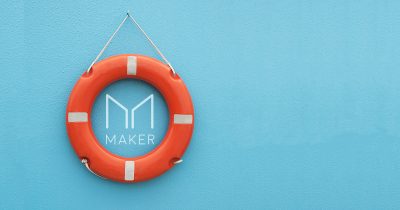Don't Bail Out MakerDAO

Share this article
MakerDAO, the “decentralized” bank, went through a mass liquidity crisis. But Maker’s problems extend beyond a single shock—centralization left them doomed from the start.
The 2008 DeFinancial Crisis
Have you heard this story before:
- Bank finances its investments with an asset, provided by customers.
- Bank uses those assets to back something else, based on people’s confidence in the collateral.
- Major turmoil grips the market and the underlying asset becomes unstable. Suddenly, people want their money back.
- Bank offers some other unbacked guarantee instead to fill the gap, allowing them to profit.
- Everyone loses, except the bank. The end.
Does this sound like something from 2008?
Well, in fact, this story happened just last week. MakerDAO went through its own liquidity crisis. Simply swap ETH for mortgages, DAI for mortgage-backed securities, and USDC for credit default swaps.
Don’t believe me? Maker’s own advertising compares the platform to mortgage-backed loans:
Financialization is a virulent mindset, and MakerDAO is sick with it. Take, for example, the growing evidence of the Maker Foundation’s participation in their own debt auctions. Even if they’re “priming the pump,” such behavior reeks of the same sort of share inflation seen on Wall Street.
The 1% Stands to Benefit from Maker
It’s important to ask who benefits from Maker’s success to see where the incentives are. In reality, only a few lucky wallets will benefit from an increase in MKR’s value.
This is evident based on the major tokenholders. Between the MKR Development Fund and primary voting contracts, the top 25 wallet addresses own over 99% of all existing tokens. To make matters worse, the anonymous nature of blockchains makes it difficult to hold these parties accountable.
Though, it is possible to piece together who holds the bags: Dragonfly Capital Partners and Paradigm have acquired a total $27.5 million in MKR—5.5% of global supply. Polychain Capital, a16z and 1confirmation are a few of the other funds who funded MakerDAO.
These funds would like to say they’re helping to build the future of DeFi, but their presence makes the decentralization of the platform questionable. Most crypto enthusiasts don’t have millions to throw around. And, for context, Bitcoin didn’t need venture capital.
Major investors, of course, want their millions protected. So, to stabilize DAI, Maker opened their vaults to USDC. Why is this problematic? USD Coin is a permissioned and censurable asset, which puts the platform at the mercy of governments. May as well back DAI with fiat.
Dai Only works, Until It Matters
Maker’s promises are meaningless when USDC can be frozen at the discretion of Circle’s global blacklist.
In the event that DeFi becomes a disruptive force, and financial statutes are enacted to outlaw it, would Maker—and anyone else relying on them—survive collapse? Or, maybe MakerDAO would get sucked into the vortex of traditional finance, making it no better than old institutions it originally sought to replace.
In short, MakerDAO’s “decentralized autonomous organization” is not decentralized, nor autonomous, nor organized. In their desperation to save their platform, its administrators have entirely abandoned the promises that originally drew crypto enthusiasts to their model.
The admins and their supporters would, of course, argue that what they’re doing works. Of course it does. Traditional finance is already proven, and it works—in the short term.
However, in the long run, it’s only a matter of time before abuse takes over the system and brings things crashing down, just like in 2008.
MakerDAO Is Centralized Finance
If it isn’t stopped, the same collusion and rampant abuse on Wall Street will pervade DeFi.
By stabilizing their coin with fiat, MakerDAO has signified that they’ve given up. If people in DeFi wanted dollars they would have purchased Treasury Bonds.
Now, MakerDAO’s only innovation has been creating a “bank-on-the-blockchain.” And, as other traditional financial firms consider building their own networks, it stands to reason that Maker’s current path won’t lead to much success.
In the end, people shouldn’t waste their time bailing out MakerDAO when more promising paths to decentralization still exist.
There Is Another Way to DeFi
There are several examples of projects doing it right. Kava is a DeFi platform with similar lending facilities to MakerDAO, but it offers loans on a wide range of collateral, including Bitcoin, Binance Coin, and XRP. Notably, the Kava platform is a purpose-built blockchain designed to handle hyper-volatility and intense liquidity events, the same issues that are currently causing problems for MakerDAO.
Other self-stabilizing tokens are being built without the obfuscated centralization of DAI. AMPL, for example, with its internal inflation protocol, allows for an internally regulated economy with less risk of meddling from executives.
This kind of creativity is exactly what DeFi needs. The field will live and die by its tools, and shoddy imitations of current finance won’t do.
Banking, by definition, requires a certain level of administration. Banking is flawed because human discretion is flawed. The boom and bust cycle won’t end until the human component is mitigated.
DeFi allows for this kind of future. More creative, self-governing code can change the face of finance. Players from Facebook to Goldman Sachs understand this. Unfortunately, they’re attempting to pollute the space with “x-on-the-blockchain” projects instead of tapping into the transformative promise of blockchain technology.
In all, MakerDAO’s thinly veiled attempt to make a “bank-on-the-blockchain” is just another vacuum of the imagination. There is another way. Instead of letting this define DeFi, people should make one simple demand: No banks and no gatekeepers.
This time, we don’t have to wait for another collapse and another bail out. It’s possible to use technology to create something entirely new, the world is simply waiting for the right people to make it happen.
This sponsored guest post was brought to you by Ampleforth, Crypto Briefing’s preferred DeFi partner. Recognition due to co-author Andrew Prensky, with contributions from Richy Qiao.
Share this article
